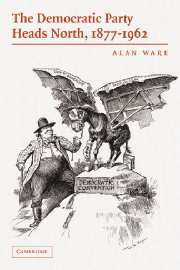Book contents
- Frontmatter
- Contents
- List of Tables
- Preface
- 1 The South and the Democratic Coalition
- 2 The Dynamics of Party Coalition Building
- 3 The Unstable Party Equilibrium, 1877–1896
- 4 The Re-assembling of the Democratic Coalition, 1896–1912
- 5 Woodrow Wilson and the Failure to Re-shape the Democratic Coalition, 1912–1920
- 6 How Could a Winning Democratic Coalition Be Constructed, 1920–1932?
- 7 Democratic Party Dominance or Restored Party Equilibrium, 1938–1952?
- 8 The Two Parties' Coalitions Come Under Threat, 1952–1962
- 9 Conclusions
- Appendix: Note on Data Sources
- Bibliography
- Index
6 - How Could a Winning Democratic Coalition Be Constructed, 1920–1932?
Published online by Cambridge University Press: 15 December 2009
- Frontmatter
- Contents
- List of Tables
- Preface
- 1 The South and the Democratic Coalition
- 2 The Dynamics of Party Coalition Building
- 3 The Unstable Party Equilibrium, 1877–1896
- 4 The Re-assembling of the Democratic Coalition, 1896–1912
- 5 Woodrow Wilson and the Failure to Re-shape the Democratic Coalition, 1912–1920
- 6 How Could a Winning Democratic Coalition Be Constructed, 1920–1932?
- 7 Democratic Party Dominance or Restored Party Equilibrium, 1938–1952?
- 8 The Two Parties' Coalitions Come Under Threat, 1952–1962
- 9 Conclusions
- Appendix: Note on Data Sources
- Bibliography
- Index
Summary
One of the temptations in historical analysis is to assume that what would later appear to be a successful solution to a problem should have been obvious to most actors at the time. If the western progressives were alienated from the Republican party in 1912, as a Democratic leader, why not court them? If a Super West coalition could win in 1916, why not persist with it? To understand why such a coalition did not appear to be the obvious strategy in the years from 1916 to 1932, we must return to the issue of how the potential for building a majority Democratic coalition changed after the early to middle 1890s.
In the post–Civil War era, it was quite clear what the Democrats had to do to win a national majority – carry enough of the small number of marginal Old North states to add to their strongholds in the ex-slave states. After 1892–5, the optimal strategy became more complex. The Border states were no longer as reliable as they had been, and the Democrats now had hopes of winning in some of the western states, as well as continuing to do so in part of the Old North. The earlier strategy could still be the basis for some successes, as it was in the congressional elections of 1910, but to the extent that there were divergent interests between East and West, the Democrats were now faced with a dilemma.
- Type
- Chapter
- Information
- The Democratic Party Heads North, 1877–1962 , pp. 146 - 174Publisher: Cambridge University PressPrint publication year: 2006

